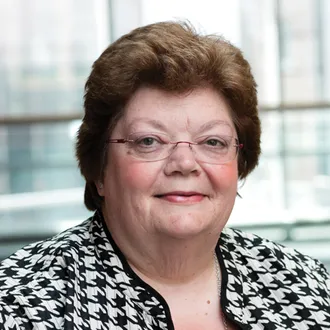How to Include a Pharmacist in the Palliative Care Mix

Meet Eleanor.
Eleanor is seventy-six years old and has been admitted to the hospital with respiratory distress related to an exacerbation of Chronic Obstructive Pulmonary Disease (COPD), requiring a mechanical ventilator in the intensive care unit. In addition to COPD, Eleanor has type 2 diabetes, hypertension, and mild dementia. She lives alone in her own home, with support from her three daughters and extended family.
The hospital is one of a handful in the country with access to a pharmacist with specialty training in palliative care, and this pharmacist conducts a symptom assessment. The pharmacist recognizes that Eleanor has symptoms consistent with delirium and that despite the mechanical ventilator, she is still reporting shortness of breath. The pharmacist conducts a thorough medication history with the community pharmacy, the external medication history in the electronic health record, and the daughter responsible for managing her medications. The pharmacist makes recommendations to optimize her sedation while weaning mechanical ventilation in an effort to minimize further delirium. She also recommends low dose opioids to help manage her shortness of breath.
During a goals of care meeting, the palliative care team learns from the family that although Eleanor is successfully weaning off the ventilator, she would not wish to be placed back on it if she deteriorates in future. The pharmacist assesses Eleanor’s medication use behaviors – asking about appetite and adherence – to ensure that Eleanor’s medications are aligned with her newly determined goals of care. The pharmacist learns that Eleanor has been fighting her family at meal times, frequently refusing to eat or to take her medication on schedule or at all, and she has fallen twice in the past two weeks. The pharmacist notes that her blood pressure and HBA1C readings in the hospital have been normal without her usual medications, and recommends deprescribing her low dose beta blocker and diabetes medications.
Prior to discharge, the pharmacist meets with Eleanor to review the medication plan and assess how well she is able to use her inhaler. Based on Eleanor’s difficulties with the inhaler, the pharmacist obtains a spacer to ensure the medication is delivered properly and perhaps delay the next exacerbation. She meets with the family to educate them on the new plan with a streamlined medication list focused on optimizing COPD therapy and quality of life.
Palliative Care Pharmacy is Coming of Age
For complex patients such as Eleanor, pharmacists are gaining recognition as valued members of interdisciplinary palliative care teams. They are expanding their practice across different settings of care, and educating patients and their families, colleagues, and health system leaders about medication use in serious illness.

This role has become increasingly valuable in the context of the national opioid crisis. The Society of Pain and Palliative Care Pharmacists (SPPCP), founded in 2015, has forged relationships with several national organizations including the National Coalition for Hospice and Palliative Care and the National Quality Forum. And in 2018, the fourth edition of the National Consensus Project’s “Clinical Practice Guidelines for Quality Palliative Care” included pharmacists as recommended members of interdisciplinary teams for the first time.
But there is a lot more work to do.
According to the National Palliative Care Registry, only thirty-six adult palliative care programs reported a pharmacist as part of their interdisciplinary team in 2018, representing 8.6% of reporting programs; and four pediatric palliative care programs reported a pharmacist, representing 7.4% of reporting pediatric programs.
In 2018, "only thirty-six adult palliative care programs reported a pharmacist as part of their interdisciplinary team."
As a field, palliative care pharmacy shares many of the barriers faced by the other palliative care disciplines: a limited workforce relative to patient needs, too few specialty training programs to bridge the gap, questions over how best to deploy limited pharmacy resources for the best quality patient care, and the pressure to measure quality outcomes and cost savings in an increasingly value-driven healthcare landscape.
Three Strategies for Palliative Care Programs to Partner with Pharmacists
To help overcome some of these challenges, we suggest three strategies for how palliative care programs can partner with pharmacists – ideally as part of the interdisciplinary team, but otherwise drawing on other health system or community resources: (1) educate colleagues on how pharmacists can support their work, (2) integrate pharmacy assessments into program workflows, and (3) demonstrate value whenever possible.
1. Educate: Pharmacists provide valuable support for palliative care teams
Pharmacists can play a unique role in reducing the suffering of people living with a serious illness. Patients with a serious illness and/or multiple comorbidities live with complex pain and symptom burdens, and they often take multiple medications. With disease progression, many patients with a serious illness may experience a “medication cascade” in which they accumulate medications to treat and prevent symptoms. This increases the risks of adverse effects, drug interactions, non-adherence, and difficulty accessing needed drugs.[i],[ii],[iii] In a recent study, polypharmacy was also associated with lower quality of life.[iv] Pharmacists with palliative care training are experts in preventing, detecting and resolving these problems.
Pharmacists can, for example, conduct comprehensive pain and symptom assessments, recognize the need for additional drug therapy in response to unmanaged symptoms or disease progression, and identify unneeded drugs and support safe deprescribing. They can also adjust dosages and compound special formulations, safely convert opioid doses, assess interactions from complementary therapies, advise on the compatibility and stability of multiple drug combinations, and provide guidance on “off-label” use of medications. Pharmacists also play an important role in managing patient transitions between settings of care, when most medication errors occur and when patients can have trouble accessing newly prescribed and needed medications.
"Once palliative care teams have a dedicated pharmacist on board, they typically don’t want to practice without one."
All this can save considerable time and effort for the rest of the interdisciplinary team, while also boosting overall team efficiency and confidence with making medication decisions. By integrating pharmacy expertise, palliative care teams can provide valuable support for over-burdened teams striving to meet the needs of their patients and build resilience.[v] Once palliative care teams have a dedicated pharmacist on board, they typically don’t want to practice without one.
Unfortunately, the supply of palliative care pharmacists is limited and training programs are few. Pharmacists complete a one-year general residency program after they graduate; they can then specialize with a second residency year, followed by a fellowship year if they choose. There are only twenty-five pain management/palliative care PGY2 residencies for pharmacists in the United States, and just a handful of fellowship programs. This compares with 110 oncology PGY2 pharmacy residencies, for example. For the majority of palliative care programs that are still without a dedicated palliative care pharmacist, partnerships with pharmacists from their health systems or communities can add tremendous value, provided the interdisciplinary team can help the pharmacist with additional training needs and/or make decisions collaboratively. Specialty training is essential for pharmacists caring for seriously ill patients, and programs must be cautious about risk management for their patients in this regard. Health systems can support the palliative care pharmacy workforce by encouraging and/or providing mid-career training for pharmacists to expand their skills.
2. Integrate: How to deploy pharmacy resources for maximum impact
In a perfect world, a palliative care pharmacist could be embedded with every interdisciplinary team caring for seriously ill patients, but in the absence of the army of pharmacists needed, palliative care programs need models that can maximize the pharmacy resources they have.
Education is the first step, so that the clinical team appreciates the pharmacist’s unique lens for assessment and knows when it is appropriate to call for a pharmacy consultation. Pharmacists can also be granted a voice in palliative care program leadership, to help advocate for resources when needed and to support pharmacists to practice at the top of their license. This is the approach that has been adopted at MedStar Health in Maryland/District of Columbia. That said, the best model for integration will always depend on the individual practice setting and number of patient consults. The American Society of Health System Pharmacists recommends that pharmacists create a scope-of-practice document that explicitly describes their role within the interdisciplinary team, with guidelines for communication, referral, and documentation of services. Interdisciplinary teams partnering with health system or external pharmacy resources can do the same.
Another way to consider pharmacist integration is to use criteria embedded in the electronic health record that will trigger a consultation with the pharmacist. Triggers are blunt instruments that have drawbacks – they cannot capture all scenarios in which a pharmacist may be needed, for example – but they can be a reasonable place to start.
Triggers for a pharmacy consultation could include presence of delirium (often related to polypharmacy) or patients taking high risk medications such as methadone, anticholinergic drugs, multiple opioids or anticoagulants, or patients more than a certain number of medications. This may vary depending on acuity of clinical setting: five or more medications may be an appropriate trigger for a pharmacy consultation in the community, while hospitals could consider automatic consultations for patients taking ten or more medications. Triggers can also be used for patients not meeting their goals of care for pain and symptom management, or goals of care that have recently changed, or a change in care setting. When managing a new patient admission transitioning from an inpatient or other setting, some programs may require a pharmacist review for new patients admitted who have been on methadone or transdermal fentanyl for under a week, and those taking daily doses of oral morphine above 200mg/day.
3. Demonstrate: Make the business case with measurable outcomes whenever possible
At the Society of Pain and Palliative Care Pharmacists, work is underway to develop a universal business case for palliative care pharmacy, much as CAPC has developed the business case for other members of the interdisciplinary team. Pharmacists are not billable providers, so as with other non-billable members of the interdisciplinary team such as chaplains and social workers, programs must find ways to measure pharmacist contributions to patient care that demonstrate value for the organization. This is all the more important for pharmacists because they command higher salaries relative to other members of the interdisciplinary team.
"As with other non-billable members of the disciplinary team, [...] programs must find ways to measure pharmacist contributions to patient care that demonstrate value for the organization."
Measuring outcomes can be challenging, however, especially when targeting consultative clinical practice where the outcomes may be avoidance of medication errors and interactions, for example. One strategy can be to use productivity measures to argue that the pharmacist saves considerable time and makes the rest of the interdisciplinary team more efficient and effective. In addition to expected business guidance from the Society for Palliative Care Pharmacists, programs can make the business case for a palliative care pharmacist based on the priorities of the health organization, so it’s important to listen carefully to leadership and make a “consultative sale”. At MedStar, the health system has developed business cases for integrating pharmacy consultations customized to the priorities of each site of care – for one hospital, this meant demonstrating how pharmacists could help reduce length of stay, for example.
In conclusion
Palliative care pharmacists can make valuable contributions to some of the most over-burdened teams in the healthcare system, caring for the sickest and most vulnerable patients. The field has made great progress in the last five years and we are excited to see what the next five will bring.
CAPC Resources
Are you thinking of adding a pharmacist to your palliative care team? In addition to the resources mentioned through this blog post, the below CAPC resources may be useful for you:
- Episode of CAPC's podcast, Program Spotlight: Integrating a Pharmacist into the Palliative Care Team
- Recorded webinar, It's a Team Sport: Models of Palliative Care Pharmacy Practice
- Staffing model, Expanding Practice: PHARMD and SW Led Palliative Consults
Endnotes
-
[i] Goldberg, R.M., Mabee, J., Chan, L., and Wong, S. Drug-drug and drug-disease interactions in the ED: analysis of a high-risk population. Am J Emerg Med. 1996; 14: 447–450
-
[ii] Steinhauser, K.E., Christakis, N.A., Clipp, E.C. et al. Factors considered important at the end of life by patients, family, physicians, and other care providers. JAMA. 2000; 284: 2476–2482
-
[iii] Weng, M.C., Tsai, C.F., Sheu, K.L. et al. The impact of number of drugs prescribed on the risk of potentially inappropriate medication among outpatient older adults with chronic diseases. QJM. 2013; 106: 1009–1015
-
[iv] Schenker, Y., Park, S.Y., Jeong, K. et al. J GEN INTERN MED (2019) 34: 559. https://doi.org/10.1007/s11606-019-04837-7
-
[v] Kamal, A. H., Wolf, S. P., Troy, J., Leff, V., Dahlin, C., Rotella, J. D., … Myers, E. R. (2019). Policy Changes Key To Promoting Sustainability And Growth Of The Specialty Palliative Care Workforce. Health Affairs, 38(6), 910–918. https://doi.org/10.1377/hlthaff.2019.00018
As told to Saskia Siderow, Ormond House LLC

